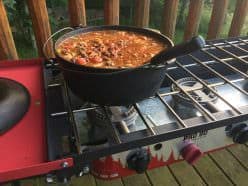Elk Shoulder Recipe
SHARE THIS POST
Pick up any magazine or browse the news online, and you’ll find mixed reviews about which foods are good for you and which ones you should avoid. With so much information out there (and plenty of it being of dubious quality), I want to clear the air on how we can enjoy healthy foods that come from nature without worrying about causing long-term damage to our bodies in the process.

Let’s start from the beginning:
How did I get this protein?
Anybody who reads my column in MidWest Outdoors will know that I go into the field to get my own meat. I’m a hunter, and enjoy cooking with the meat that I bring home. Just the process of going into the field to hunt is healthy. We get fresh air and exercise, and we bring home meat that is organic and hormone-free. After I harvest an animal, I work to use every part of it that I can. In some animals, this includes organs, which can be extremely healthy for us to consume.
Because this meat comes from such a healthy place to begin with, I want to ensure that the cooking process doesn’t neutralize those efforts.
How do I prepare this protein?
When preparing wild game you have quite a few options, and with trial and error you will ultimately find the method that best fits your needs and preferences. For example, we grill or smoke a lot of our meats because we like the flavor and experience that it provides. There is a debate on which method is healthier: To grill or to smoke?
In my opinion, it comes down to a question: How often are you preparing your food this way?
I’ll go through some of the details concerning your health and how you can avoid long-term affects from your protein preparation.
The truth behind smoking
The art of smoking meat has been around for ages, and many people tend to rely on this as their primary method of preparing their food. If you use wood chips to flavor the smoke that cooks the meat, be cautious about the polyaromatic hydrocarbons that are released through the smoke into the meat. This is a form of carcinogens and can be harmful to your health if you eat smoked meat every day. Most people don’t consume enough smoked meats for it to be an issue, but if you are concerned about it then you can consider switching to liquid smoke to flavor your meats during the cooking process. The carcinogens are still present in bottled liquid smoke, but most studies are showing that the levels are much lower and safer for consumption.
Overall, the health benefits of smoking foods definitely outweigh some of the alternatives. The flavor is undeniably great, you don’t need to add calories with fats or cooking oils when you use this method and lean protein is proven to be a healthy addition to almost any diet.
Grilling: a national pastime
If you see ads for products, television commercials, or even just walk through most neighborhoods in our country, you’re probably going to find images of people grilling in their backyards. My own family uses this method of cooking more than most others. It’s quick, easy and we love how grilled food tastes.
The one thing you need to be aware of is that when the moisture from the fat drips down into the flames it creates that same carcinogen that I mentioned above.
The words “polycyclic aromatic hydrocarbons” don’t sound delicious to anybody. The good news is that small doses of this chemical probably won’t hurt you. I say “probably” because different studies are still being conducted on the long-term effects.
I have two recommendations for cutting your risk of taking in carcinogens from grilled meat. First, cut away the charred pieces of your meat before you consume it. That dark char is where most of those chemicals will be found, so if you want to reduce your risk of harm just cut it away and consume the rest of it.
Are you enjoying this post?
You can be among the first to get the latest info on where to go, what to use and how to use it!
My second suggestion is to use something under your meat on the grill to reduce flare-ups and fluids dripping into the flame. Tin foil will work, but we usually use a Himalayan salt block, which can be found online if you search for it.

The salt block flavors the meat as it’s cooking (you rarely even need to marinate it ahead of time) and can be used for a lot of different purposes related to cooking, serving, and preparing different foods. I choose Himalayan salt because your body is able to process it differently and more organically than regular white table salt, and it has many health benefits.
If you’re looking for alternatives to marinades or dipping sauces and you want a healthier option, consider trying a salt block.
Other methods of preparation
I typically use a slow cooker in my home about once a week. I’ve found that it makes my hectic life more bearable if dinner is ready without a lot of preparation, and my husband loves to have a hearty meal. The downside of slow cookers is that there can be a lot of additional calories consumed because of sauces, marinades, or in our case, the carbohydrates that go deliciously with slow-cooked meals. (One of my favorite slow cooker recipes is elk shoulder with vegetables.)

Another healthy alternative to grilling or smoking is the old-fashioned use of cast-iron Dutch ovens. When we camp out we use this method almost every night. Over the years we’ve found some incredible recipes that utilize hot burning coals and a Dutch oven, so I’ve shared one of my favorites with you below! The trick is to know how many hot coals to put on top of the lid and how many to put below the pot. The perfect combination of heat surrounding the Dutch oven will make a huge difference. The other good thing about this method is that you avoid the Teflon material that is common in many modern-day cooking vessels. And don’t forget, many people and studies swear that cast iron actually adds iron into the food that’s prepared in it. If your diet is low in iron, this may be a healthy solution for you.
It seems like every method of food preparation can have pros and cons, so choose the methods that you enjoy the most and go with them. This article is not meant to scare you away from any particular method, but I believe that you should know what is going into your body and what the potential long-term effects might be. Even though I know that some carcinogens might be going into my body, I consume grilled and smoked meats in small portions. If it was an everyday part of my diet in large quantities, then I might make a decision to cut back based on the information in front of me.
With so many options on different ways to prepare meat, I highly recommend that you experiment with methods until you find what works best for you.
Elk Shoulder Recipe
This is a recipe that I use with an elk shoulder, but you can substitute any large cut of meat if you don’t have an elk in your freezer.
1 elk shoulder, approximately 2 pounds
Hi Mountain Seasonings Cajun Campfire Western Style Seasoning
2 cups of beef broth (or water with beef flavored cubes)
Sweet potatoes
Onion
Peppers
Rub seasonings directly onto thawed meat. Place entire cut of meat into the slow cooker. Pour broth over meat. Add sweet potatoes, onions and peppers on top of the meat.
Cook on high setting for 4 hours, and then reduce heat to low for 2 more hours. If meat is frozen, add an additional 40 minutes to the overall cook time. For additional flavor, sprinkle more seasonings on top of the vegetables about halfway through cooking time.
Send Julie your outdoors-specific exercise and nutrition questions, at any of our social media pages. Like us at facebook.com/MidWestOutdoorsTV, facebook.com/JulieMcQueen.brotherhood, and follow our Instagram feeds @mwoutdoor and @julesmcqueen. “Fitness for the Field” is peer-reviewed by trainers and nutritionists at UpLift Guided Fitness in Woodbury, Minn. Eat healthy for the rest of your outdoor-loving life at upliftfitness.com/21dayoffer.
MWO
SHARE THIS POST
You may also like...
Did you enjoy this post?
You can be among the first to get the latest info on where to go, what to use and how to use it!
Julie McQueen
Send Julie McQueen your outdoors-specific exercise and nutrition questions, at any of our social media pages. Like us at facebook.com/MidWestOutdoorsTV, facebook.com/JulieMcQueen.brotherhood, and follow our Instagram feeds @mwoutdoor and @julesmcqueen. “Fitness for the Field” is peer-reviewed by trainers and nutritionists at UpLift Guided Fitness in Woodbury, Minn. Eat healthy for the rest of your outdoor-loving life at upliftfitness.com/21dayoffer.



